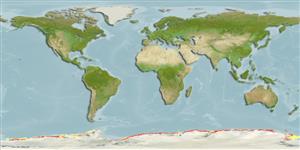>
Perciformes/Notothenioidei (Icefishes) >
Nototheniidae (Cod icefishes) > Trematominae
Etymology: Trematomus: Greek, trematos = hole + Greek, tomo = section, cut (Ref. 45335); nicolai: Named after Nicolai Hanson, biologist and collector of Southern Cross fishes, died at Cape Adare during the expedition (Ref. 11892).
More on author: Boulenger.
Issue
The genus Pseudotrematomus is a synonym of Trematomus, which is confirmed by a molecular study to be published (J.-C. Hureau, pers. comm. 08 Jun. 2010).
Environment: milieu / climate zone / depth range / distribution range
Ecología
marino demersal; rango de profundidad 1 - 420 m (Ref. 11892). Polar; 65°S - 78°S
Distribución
Países | Áreas FAO | Ecosistemas | Ocurrencias, apariciones | Point map | Introducciones | Faunafri
Southern Ocean: East Antarctica (some localities), but not from the Peninsula region and westward to the Ross Sea. Coasts of Adelie Land, Davis, Weddell, South Shetland and South Orkney Islands.
Tamaño / Peso / Age
Maturity: Lm ? range ? - ? cm
Max length : 36.0 cm TL macho / no sexado; (Ref. 5179); peso máximo publicado: 0.00 g
Short description
Morfología | Morfometría
Espinas dorsales (total): 4 - 5; Radios blandos anales: 31 - 35. Body brownish, more or less distinct dark crossbars, scattered small dark spots, fins dusky, spiny dorsal blackish (Ref. 11892).
A nearshore benthic species usually abundant in shelf waters of East Antartica (Ref. 122792). Adults feed primarily on amphipods, other fishes, and molluscan larvae, with lesser amount of polychaetes and mysids. They capture some prey in the water column, but are not cryopelagic.
Dewitt, H.H., P.C. Heemstra and O. Gon, 1990. Nototheniidae. p. 279-331. In O. Gon and P.C. Heemstra (eds.) Fishes of the Southern Ocean. J.L.B. Smith Institute of Ichthyology, Grahamstown, South Africa. (Ref. 5179)
IUCN Red List Status (Ref. 130435)
Threat to humans
Harmless
Human uses
Pesquerías: sin interés
Más información
ColaboradoresImágenesStamps, Coins Misc.SonidosCiguateraVelocidadTipo de nataciónSuperficie branquialOtolitosCerebrosVisión
Herramientas
Special reports
Download XML
Fuentes de Internet
Estimates based on models
Preferred temperature (Ref.
123201): -1.8 - -0.4, mean -1.4 °C (based on 382 cells).
Phylogenetic diversity index (Ref.
82804): PD
50 = 0.5005 [Uniqueness, from 0.5 = low to 2.0 = high].
Bayesian length-weight: a=0.00631 (0.00419 - 0.00951), b=3.21 (3.08 - 3.34), in cm total length, based on LWR estimates for this species & Genus-body shape (Ref.
93245).
Nivel trófico (Ref.
69278): 3.6 ±0.53 se; based on food items.
Generation time: 13.7 ( na - na) years. Estimated as median ln(3)/K based on 2
growth studies.
Resiliencia (Ref.
120179): Medio, población duplicada en un tiempo mínimo de 1.4-4.4 años (Fec = 8,900).
Fishing Vulnerability (Ref.
59153): Moderate to high vulnerability (51 of 100).
